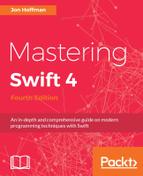Behavioral design patterns explain how types interact with each other. These patterns describe how different instances of types send messages to each other to make things happen.
There are nine well-known patterns that are part of the behavioral design pattern type. They are as follows:
- Chain of responsibility: This is used to process a variety of requests, each of which may be delegated to a different handler.
- Command: This creates objects that can encapsulate actions or parameters so that they can be invoked later or by a different component.
- Iterator: This allows us to access the elements of an object sequentially without exposing the underlying structure.
- Mediator: This is used to reduce coupling between types that communicate with each other.
- Memento: This is used to capture the current state of an object and store it in a manner that can be restored later.
- Observer: This allows an object to publish changes to an object's state. Other objects can then subscribe so they can be notified of any changes.
- State: This is used to alter the behavior of an object when its internal state changes.
- Strategy: This allows one out of a family of algorithms to be chosen at runtime.
- Visitor: This is a way of separating an algorithm from an object structure.
In this section, we are going to give examples of how to use strategy and command patterns in Swift. Let's start off by looking at the command pattern.
